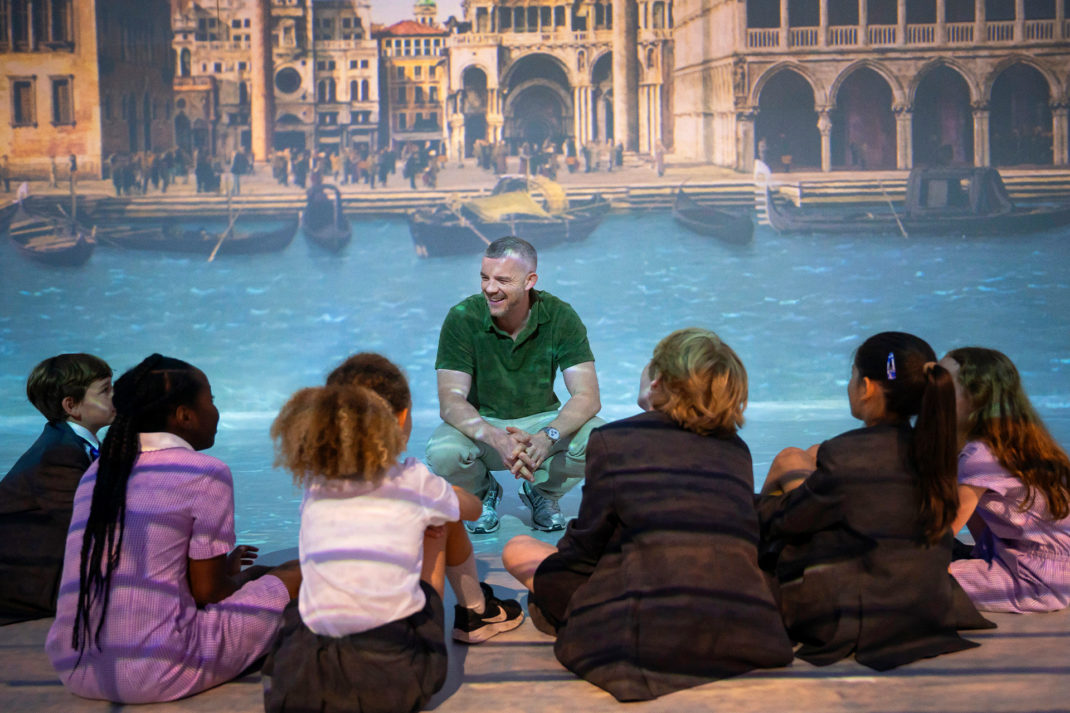Grenada: Paradise Island For Families
By
2 years ago
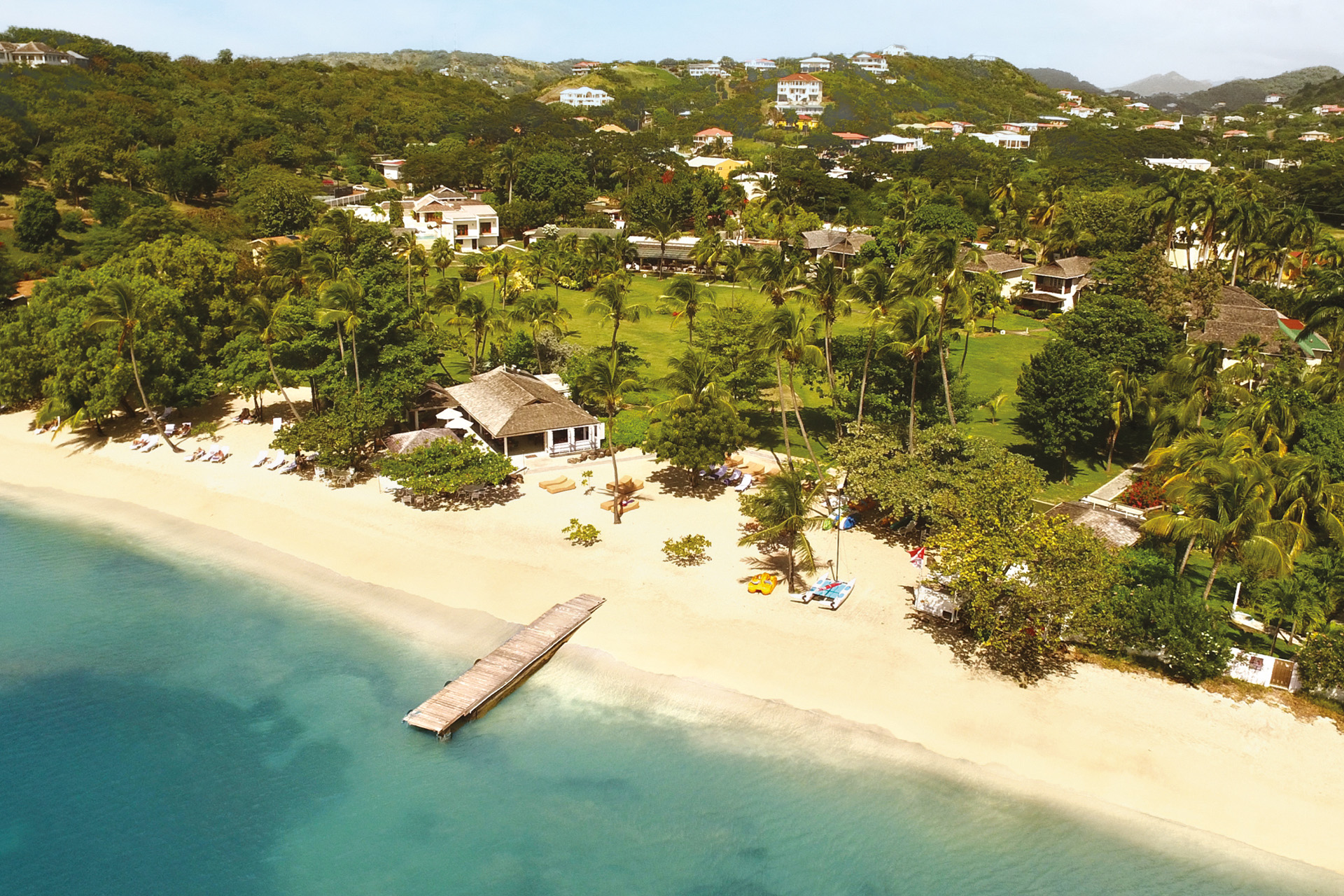
Vibrant and welcoming, Grenada is the perfect place for a lively family holiday, finds Victoria Lambert
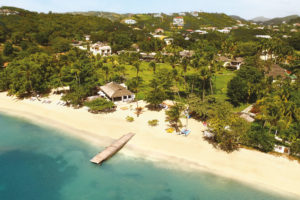
Coastline of Grenada
The air was warm and sweet, with the promise of a tropical shower. The earth dark red-ochre, and above, abundant bright green plants and trees heavy with fruit. Curlan, our guide, plucked a shiny viridescent orb, and handed it to Theo. ‘Open that,’ he instructed, ‘and tell me what it is.’
Theo obliged. ‘It’s citrus,’ he said, smelling it. ‘But what kind?’ Even biting into the pale pinkish segments didn’t help at first. Then, ‘But it’s sweet… it’s… grapefruit. But it doesn’t taste like grapefruit at home.’
Curlan laughed. He knew eating fresh Grenadian fruit was always going to be a revelation. From mangoes to avocados, melon to bananas, it all tastes fresher and sweeter on the island.
With that, Theo and Rowena, both 18 and celebrating the end of A-levels, were off: picking and tasting satsumas, dragon fruit and the clear favourite: star fruit – a sort of delicate apple-melon flavour. The pair have been best friends since Reception, at Bedales School’s Pre-prep Dunannie, and frankly had I known this was the way to get them to eat fruit, I might have booked flights to Grenada 14 years ago.
Still, we are here now, having flown 10 hours across the Atlantic, with a pit-stop in St Lucia, to this small volcanic Commonwealth island, independent but with King Charles as head of state. These British connections make it easy for the UK visitor; locals speak English, drive on the left and love cricket. But its location, at almost the most southerly end of the string of sparkling Caribbean islands, 90 miles north-east of Venezuela and Trinidad, means it has a unique feel derived from its complex heritage and modern influences, most evident in its cuisine, which covers West African, Indian, French, British, North, South and Latin American and, of course, the Caribbean.
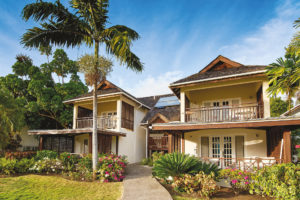
Calabash suite
We’ve chosen to stay at Calabash, an award-winning Relais & Châteaux luxury boutique hotel with a long and charming history. Its British-Grenadian owners, Leo and Lilian, met and fell in love, buying the hotel in 1987 to make a base, and turning it into a welcoming yet glamorous home from home, which has seen families return annually. The location is postcard-perfect; a horseshoe-shaped array of suites and villas looks down to a stunning white sand beach and private bay. Outside, the gardens are stuffed with well-established native plants and trees – everything from towering palms to clumps of pink bougainvillaea and bright orange tiger lilies. Inside, the suites are generous – with king-sized beds, air conditioning, luxury bathrooms and a helpful Alexa. The newly renovated penthouse suite has a magical living-dining space that opens up fully on to a private pool, and features impeccable modern design: white walls and blond wood, gleaming chandeliers and a generous free-standing bath tub.
But what really makes Calabash stand out is its people. Everywhere there are delightful, warm and cheerful staff who have perfected that sweet spot between efficient, discreet and friendly. Whether it was keeping rooms immaculate or dropping by with a daily complimentary canape before dinner or just stopping for a chat, service was perfect.
And it is through Calabash that our excursions are arranged: to L’Esterre, the organic fruit farm home to all those star fruits, which is owned by Lilian’s family, the Ramdhannys; the first generation of which arrived as indentured workers from India. Later, there will be a trip to a legendary local restaurant called Dexter’s – where we eat a five-course dinner, watching the sun set from an open-faced verandah, fans swirling overhead.
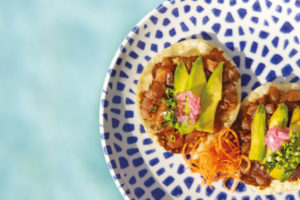
Eat dinner while watching the sun set from an open-faced verandah
But our first jaunt is to one of the island’s most popular attractions: the Seven Sisters Waterfall set in the 3,816-acre Grand Etang National Park. Waterfalls are a must in Grenada and there are five across the island which are particularly recommended – depending on your agility and stamina.
To reach the national park is an hour’s drive up winding roads from St George’s, past the stunning modern Parliament building, which looks out over the Caribbean in one direction and across to the island prison in the other. (The locals joke that the prisoners have the best views.) Not that crime is a big issue here, Grenada is known thankfully as a very safe destination.
First stop at Grand Etang is the crater lake, formed from an extinct volcano, which holds the natural water supply for the island. Nearby you may be lucky to see one of the island’s native fauna, the friendly Mona Monkey. It’s also worth keeping eyes peeled for other locals: armadillos, opossums and mongoose – the latter were brought on to the island to rid it of snakes and have largely succeeded. Nor are there any large native animals on the island; your main predator of concern will be the mosquito.
Then it’s on to the waterfall. A guide is advisable – as is the stout bamboo cane you’ll be offered, the route is steep and rough and it’s a good hour’s hike. But then the waterfall dramatically appears along with its enticing pool for a refreshing dip and some crucial Instagram opportunities. It’s one of those Ahh! moments which no successful holiday can do without.
The track back is uphill but somewhat easier, and after you leave the national park, you can stop at one of the many small roadside shops for the local soft drink Ting or a refreshing locally brewed Carib beer.
Later in the week, on the way to L’Esterre organic farm, we stop en route for some butter bread – soft inside, firm outside, doused in butter during the baking process – and tasty coconut roll or cut cake, the Grenadian version of swiss roll.
Once we arrive at L’Esterre, apart from eating as much fruit as possible, we are introduced to its environmentally friendly way of farming: intercropping. This means that trees and plants are grown together so that they benefit each other naturally. For example, cocoa trees capture carbon from the atmosphere, putting it back into the soil where it becomes food for other plants. Stronger soil regulates air and water underneath, encouraging a continuous fresh water cycle. So no nutrients and water are lost through soil erosion, maintaining resilience in the local ecosystem. We are then taken to see how the cocoa beans are fermented and sundried alongside the farm’s other major crop, nutmeg. It’s hard to understate how important the latter is to the island’s economy: Grenada’s nutmeg industry supplies nearly 40 percent of the world’s annual crop.
Both cocoa beans and nutmeg seeds, plus the red mace which surrounds the nutmeg seed and is used in a variety of products from cosmetics to preserves as well as a spice, are laid out in huge wooden drawers which can be extended into the open air by day and closed by night or in rain. The process here is deliberately organic in every way: beans and seeds are turned by hand.
Walking around the farm takes you into the island’s darker history. Plantations were established by French and English settlers in the 17th and 18th century which led to the transportation of about 12,000 slaves from west Africa; 82 percent of the population are wholly descended from them.
Some of the farm building walls are made from the ballast that arrived in British ships when they came to collect the sugar, cocoa and spices that would be sold back in England. And there are large pieces of rusted metal, remains of the rum stills that were established once Europeans had discovered sugar beet, and cane was no longer a viable crop. It’s a sobering experience and very worthwhile. You can learn more about the island’s tumultuous history at the National Museum in St George’s, or by visiting one of the Forts that have kept watch over the island for several hundred years.
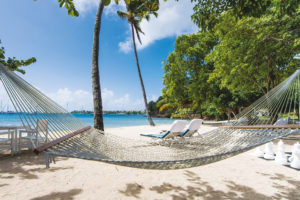
Relax on the white sand beaches in Grenada
Away from the countryside, no island holiday would be complete without exploring its waters. If you travel between March and June, you can join a turtle watching trip. And scuba divers can take a boat trip to the world’s first underwater sculpture park, with work’s by Jason deCaires Taylor. Or you can enjoy – as we do – snorkelling around the Calabash’s clear bay looking at the reef fish, sea urchins and crabs. The hotel also offers paddle boarding, pedalos, kayaks and Hobi cats to keep older teens busy, plus a tennis court, a separate infinity pool and a boutique spa for frazzled parents.
Best of all, when the sun goes down, the food at the Calabash is the ultimate reward for a hard day’s sunbathing. Rhodes Restaurant – which was opened by Chef Gary Rhodes in 2004 and is now run by Chef Ramces Castillo, offers a high standard of modern dishes, with a Grenadian twist and locally sourced ingredients, such as rum-glazed pork loin with plantain croquettes or soursop panna cotta with a star fruit salad. For a change, you can try Izakaya which provides Japanese and Latin inspired plates, some created at the table. Or grill night at the beach bar, where a local steel band provides an accompaniment to fresh shrimp, washed down with rum cocktails.
But it is breakfast which becomes our favourite meal of the day as we indulge in our passion for the selection of fresh tropical fruit which is served at the beach or on our balcony, accompanied by fluffy pancakes and french toast. Do we want to return? Of course – for the Grenadians, the beaches and yes, just one more slice of star fruit.
Book it: Audley Travel offers tailor made trips to Calabash in Grenada. An eight-night trip includes four nights at Calabash on an all-inclusive basis (with $400 resort credit) and four nights in St Lucia on an all-inclusive basis. The itinerary also includes flights, transfers and excursions, and costs from £5,400 per person (based on four travelling), audleytravel.com/grenada. For more information on Grenada, please visit puregrenada.com



